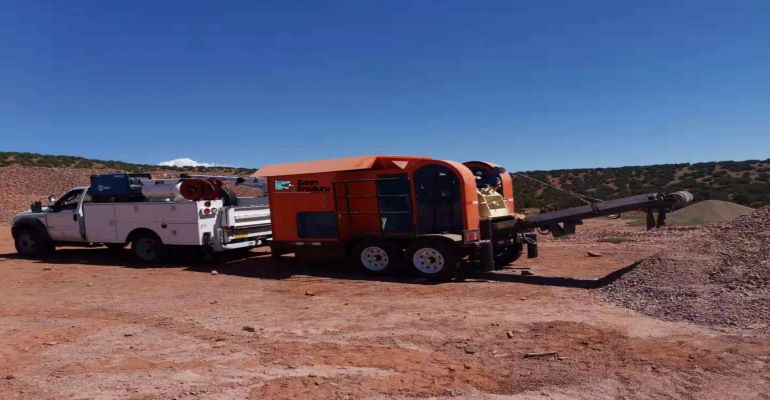Recycling Concrete on Site
Onsite crushing of hardened concrete can help control rising material costs and increase contractor productivity.

Contractors are about to be caught in a new challenge as we enter 2021. While construction activity is expected to soften, prices for many materials is on the rise. Carpenters are seeing a dramatic price increase in lumber. But contractors should also pay close attention to another rising material cost that underlays every project – crushed aggregate.
Rising aggregate prices?
In the Associated General Contractors’ October 2020 price index, construction sand/gravel/crushed stone was one of a number of materials whose cost was rising. Albeit the increase was only 4.6%, this price increase could be the difference between a good job and a profitable job. Why would aggregate costs buck the trend of price cutbacks in slow market conditions? There could be three factors that were present before than pandemic, and will be for the near future:
Quarries and sand pits face more difficulty in acquiring new reserves. In many circumstances, the challenge is more restrictive permitting, but more often than not, many sites are just depleted.
New operations tend to be further from construction activity, thus raising delivery costs.
There's a new respect for aggregate quality. Many quarry operations have restricted the use of their materials to concrete and asphalt quality standards, reducing capacity for base course material.
What can a contractor do to help control their own costs?
Many contractors are purchasing small, portable crushers to process old concrete that is on site (here's information on one such device). These contractors can create base material that can be used as fill to reduce the quantity of purchased material needed on a project. These units fit a great niche, as many tear-out and replace projects may not have enough quantity of material to justify a large portable crusher. And more often than not, these projects have small footprints with limited room for large stockpiles and crushing operations.
How do contractors create positive margins by crushing concrete? In addition to the cost of purchased material, contractors often have to pay for disposal of the hardened concrete with landfill tipping fees and transportation costs from the job site. There are few free dump site that are accepting clean construction material. In many areas, disposal costs of hardened concrete often exceed the costs of labor and equipment to crush material on site. And many contractors find that by self-recycling torn-out concrete, they have better control of a project’s critical path.
And there’s the possibility of a site developer/owner gaining LEED credits by providing recycled material on a site. This benefit may not actually put more money in the contractor’s pocket, but it can be a decision factor on a project with multiple bidders.
What to consider?
Most experts suggest starting the process by looking at past projects to compare the quantity of tear out concrete hauled from projects to the purchase quantity of fill material needed to support the subgrade and to create construction roads.Project documents should be reviewed to verify that self-generated recycled crushed concrete is acceptable as an engineered subbase, since many projects specify material be from state approved sources. But this material is gaining accepatance, especially as some jurisdictions have adopted specifications that outline the quality requirements for recycled concrete with respect to gradation and deleterious material limits. As contractors start self-crushing endeavors, frequent gradation analysis can provide important feedback.
Next, look at how these small crusher operations match your equipment fleet’s current capabilities. Most small portable crushers can be fed with medium-sized skidsteers and small backhoe/loaders. But the real question concerns your breakers. Many contractors remove large sections of sidewalk or pavement, but when feeding these crusher units, contractors will need to use impact breakers to downsize large sections of concrete to match a crusher’s opening.
This balance between breaker use and crusher size is a key purchasing decision. Larger crushers have the capacity for larger feed size. Normally the feed size constraint is the width of the slab or pavement. So many contractors opt for larger units to reduce the need for labor-intensive secondary breaking. This option also allows for greater production capacity.
Another important consideration is how to handle reinforcement that could be in the hardened concrete. Many larger crushers can be equipped with magnets on their feed belts that attract steel rebar, wire, and other embedments. These larger units also provide more crushing energy to reduce concrete with fibers,
Determine if your area allows onsite recycling/crushing under their normal construction permits. Some jurisdictions may permit a limited amount of crushing activity, especially since the process will reduce truck traffic. If they do, contractors may want to consider adding dust suppression equipment including foggers that can effectively control fugitive dust generated by crushing operations.
And finally, be sure to develop a pertinent safety protocol. There are important safety and health considerations when opting to recycle on site. The most important of these considerations is protecting workers from crystalline silica. OSHA has published a useful guide that helps outline the contractor’s responsibilities. www.osha.gov/Publications/OSHA3935.pdf.
Additional resources
For those contractors who branching into larger demolition and crushing operations on concrete projects, the National Demolition Association, www.demolitionassociation.com, offers resources to allow a comprehensive look at the challenges faced by contractors
_______________________________________
About the Author(s)
You May Also Like




